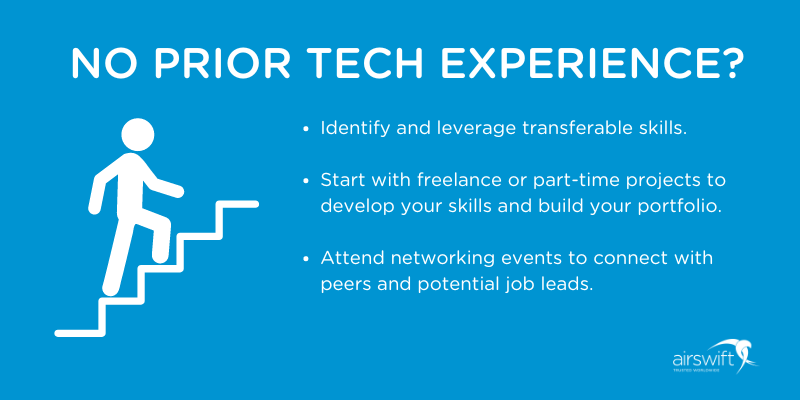With technology at the forefront of economic development and innovation, professionals from various sectors are increasingly interested in pivoting into tech roles.
"How can I transition into tech with no prior experience?"

Individuals seeking to enter the tech industry without prior experience should begin by looking into these straightforward actions:
- Identify your transferable skills: Reflect on the skills you’ve acquired in your current field that are relevant to tech. Problem-solving, project management, and analytical thinking are highly valued.
- Choose a specialisation, but be t-shaped: The tech industry is expansive, encompassing fields like web development, data science, and cybersecurity. Choose a domain that captivates you and plays to your strengths. Remember, the current job market favours 'T-shaped' professionals, so it's advantageous to demonstrate competencies that extend beyond your primary area of expertise.
The "T-shaped professional" is gaining traction in today's industry as the archetype for future professionals. This individual has deep expertise in a particular field, akin to the vertical line of the "T," while also having a broad but less extensive knowledge across other areas, symbolised by the "T's" horizontal line. This combination allows for both specialisation and valuable interdisciplinary collaboration.
- Get real-world experience ASAP: Consider internships, volunteering, or freelance work to gain practical experience. Join hackathons and other tech competitions. Even small projects can be a great addition to your resume.
- Build personal projects and a striking portfolio: Elevate your resume by developing unique tech projects that reflect your skills and building a visually engaging portfolio with relevant work, like data analysis or open-source contributions, to attract potential employers.
- Strengthen your network in tech: Getting to know people in tech can really help your career. It’s not just about swapping emails; it’s about making friends who can help you find jobs and learn cool stuff. You can meet tech folks at big conferences, online groups, or local events. Remember, it’s give and take – help others, and they’ll help you too.
- Develop fundamental tech skills: Before landing a tech job, you must know your stuff. Figure out what skills are hot in the tech world, then take online courses to learn them. Put your new skills to work on your own projects or by helping out others.
Download our 10 free AI prompts for highlighting your digital skills in your resume below
"How can I enter the tech industry with no existing qualifications?"

The best pathways into tech without existing qualifications might involve certifications in specific technologies, learning through online platforms, or attending coding bootcamps. Contributions to open-source projects are also a must-do if you plan to build a solid foundation for your new tech knowledge. Check these out:
- Online courses and bootcamps: Enroll in online courses or intensive bootcamps that offer practical, job-ready skills in areas like coding, data analysis, or UX/UI design.
- Certifications: Obtain industry-recognised certifications from organisations like CompTIA, Cisco, or Google, which can validate your skills to potential employers.
- Self-learning: Utilise free resources such as YouTube tutorials, blogs, and forums to learn at your own pace. Websites like GitHub also offer a platform to practice coding. One of our favourites is also Replit, which is a free online code editor that lets you try out different programming languages right in your browser. No setup, just code. Plus, gamification keeps learning fun with points and badges.
- Contributing to open source: Engage with the open-source community by contributing to projects. This can help you build a reputation and demonstrate your skills.
- Mentorship: Seek out mentors who can provide guidance, support, and potentially open doors for you in the industry.
So, the message here is clear: Don't stop learning! Whether you choose online courses, industry certifications, or self-directed learning through free resources, there's a path that fits your pace and budget.
"How can I navigate cultural and representation challenges?"

According to the Wiley Edge 2023 Diversity in Tech Report, individuals from underrepresented groups face notable hurdles when entering the tech industry. This is echoed by a 2022 Stack Overflow survey, which found that 92% of developers globally are men, with women making up just over 5%.

The lack of diversity is further highlighted by a survey that revealed only 22% of students could name a woman as a prominent tech figure. This lack of visible female role models, as René Girard's mimetic theory suggests—'You are who you mirror'—impedes the ability of aspiring professionals to envision themselves in similar roles.

The challenge extends beyond gender. Major tech companies’ annual diversity reports consistently show an underrepresentation of Black, Hispanic, and other minority groups, particularly in technical and leadership roles. For example, Google’s 2023 Diversity Annual Report disclosed that Black employees constituted only 5.3% of their workforce in the US and Latinx employees only 7.3%.
While some progress has been observed, much work remains to achieve genuine ethnic diversity within the tech sector.
To navigate and overcome these barriers, consider the following strategies:
- Join supportive networks: Participate in groups like Women Who Code or Girls in Tech. These organisations not only offer networking opportunities but also provide mentorship and resources that empower women in STEM.
- Opt for supportive work environments: Seek out companies that demonstrate a commitment to diversity and inclusion. A supportive workplace culture can significantly enhance your career progression and job satisfaction.
- Establish yourself as a thought leader: Initiate a blog or contribute to existing publications. Sharing your knowledge and experience helps position you as an expert in your chosen field.
- Find a mentor: Connecting with someone who has successfully navigated the tech industry can provide you with invaluable guidance and insights.
- Build a strong personal brand: A robust personal brand highlighting your unique skills and passion for technology can be a powerful tool for advancing your career. This can be showcased through a professional website, active engagement on social media, and effective networking.
"I'm over 40. Is it too late for me to transition into a new industry?"

The tech industry is often perceived as a young person’s field, leading to ageism where older workers might find fewer opportunities or face biases against their skills and adaptability. However, beginning a tech career post-40 is feasible with an approach focusing on upskilling and showcasing transferable skills.
Mature entrants should know how to highlight particularities in their career's change resume—leverage their professional network and may choose to focus on areas like project management where leadership and communication skills aree valuable assets.
- Assess your life experience: Your diverse experiences can be a significant asset. Identify transferable skills and strengths you’ve developed over the years. Leverage your soft skills, as they demonstrate your hands-on experience and emotional intelligence. This can be your ace up your sleeve, since experienced professionals are in-demand by the tech industry.
- Embrace a learning mindset: Be open to learning new technologies and methodologies. Age should not be a barrier to acquiring new knowledge.
- Choose the right path: Consider which areas of tech align with your interests and existing skills. You might find project management, quality assurance, or business analysis to be a good fit.
- Get educated: Take advantage of online courses, workshops, and bootcamps that cater to professionals transitioning into tech.
- Network with peers: Connect with other professionals who have made a similar transition. They can provide valuable insights and support.
The tech field still has a lot to offer to senior professionals, especially for who possess soft skills and leadership qualities.
"How long does it take to pivot into a tech career?"

The time it typically takes to pivot for a career in tech can vary greatly based on individual circumstances, but here are some general timelines:
- Self-taught route: If you’re learning through self-study using online resources, it could take anywhere from 6 months to 2 years to gain a solid foundation, depending on your dedication and the complexity of the skills you’re learning.
- Bootcamps: Coding bootcamps are intensive and can last from 3 to 9 months. They are designed to teach you the necessary skills quickly and prepare you for entry-level tech jobs.
- Part-time study: If you’re studying part-time while working, it might take 1 to 3 years to build the skills needed for a career change, depending on the pace of study and the depth of knowledge required.
- Formal education: Pursuing an associate’s degree can take about 2 years, while a bachelor’s degree typically takes 4 years. However, these paths offer a comprehensive understanding of the field.
- Certifications: Earning certifications can take anywhere from a few weeks to several months, depending on the certification and your prior technical skills.
- Transitioning from a related field: If you’re already in a related field, such as business or design, you may be able to pivot more quickly, potentially within a year, by leveraging your existing experience and network. It’s important to remember that these are approximate timelines and can vary widely.
Besides which study path you will take, persistence and adaptability are crucial throughout this process.
Discover the latest tech jobs with Airswift

Embarking on a tech career transition is a pivotal moment, and it’s crucial to ask the right questions before leaning into it.
At Airswift, we are present in over 60 countries and our specialised candidate platform connects you the best companies worldwide. Sign up today to discover the latest jobs within tech and engineering.




